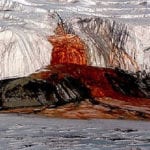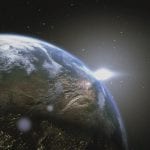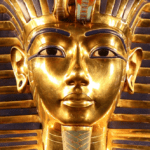 Mysteries
Mysteries  Mysteries
Mysteries  History
History 10 Surprising Stories About the Texas Rangers
 Humans
Humans 10 Philosophers Who Were Driven Mad by Their Own Theories
 Miscellaneous
Miscellaneous 10 Video-Game-Worthy Weapons and Armors from History
 Weird Stuff
Weird Stuff 10 Psychics Who Accurately Predicted Wartime Events
 The Arts
The Arts 10 Pieces of Art Inspired by a Broken Heart
 Health
Health 10 Science Fiction-Sounding New Medical Treatments
 History
History 10 Surprising Facts About the Father of Submarine Warfare
 Space
Space Ten Astonishing New Insights into Alien Worlds
 Weird Stuff
Weird Stuff 10 Bizarre Summer Solstice Rituals Still Practiced Today
 Mysteries
Mysteries Top 10 Haunting Facts About the Ghost Ship MV Alta
 History
History 10 Surprising Stories About the Texas Rangers
 Humans
Humans 10 Philosophers Who Were Driven Mad by Their Own Theories
Who's Behind Listverse?

Jamie Frater
Head Editor
Jamie founded Listverse due to an insatiable desire to share fascinating, obscure, and bizarre facts. He has been a guest speaker on numerous national radio and television stations and is a five time published author.
More About Us Miscellaneous
Miscellaneous 10 Video-Game-Worthy Weapons and Armors from History
 Weird Stuff
Weird Stuff 10 Psychics Who Accurately Predicted Wartime Events
 The Arts
The Arts 10 Pieces of Art Inspired by a Broken Heart
 Health
Health 10 Science Fiction-Sounding New Medical Treatments
 History
History 10 Surprising Facts About the Father of Submarine Warfare
 Space
Space Ten Astonishing New Insights into Alien Worlds
 Weird Stuff
Weird Stuff 10 Bizarre Summer Solstice Rituals Still Practiced Today
10 Shadowed Geniuses: Science’s Silent Trailblazers
In the vast tapestry of scientific discovery, some names shine so brightly that they eclipse others, no matter how significant their contributions. These overshadowed pioneers, though lesser-known, have shaped our understanding of the world in profound ways.
From the depths of the cosmos to the intricacies of our DNA, their relentless curiosity and groundbreaking revelations have paved the way for modern marvels. This list delves into the lives of ten such overlooked geniuses, bringing their stories out of the shadows and into the limelight they so rightly deserve.
Related: Top 10 Great Scientists Who Would Be #Cancelled Today
10 Rosalind Franklin: The DNA Detective Overshadowed by “Photograph 51”
Rosalind Franklin, sometimes referred to as the “unsung heroine” of DNA’s discovery, was a powerhouse in molecular biology. With her unparalleled skills in X-ray diffraction, she captured the iconic “Photograph 51.” This wasn’t just any photograph; it was the key that unlocked the double helix structure of DNA, paving the way for one of the most monumental scientific revelations of the 20th century.
But here’s where the tale takes a twist. Instead of a celebratory champagne toast, Franklin’s groundbreaking work was sneakily shared with James Watson and Francis Crick. This duo then sprinted to the spotlight with the DNA model, leaving Franklin in their dust. As they soaked up accolades and even clinched a Nobel Prize, Franklin’s indispensable contribution was overshadowed. Imagine crafting a chart-topping melody only to be dubbed “that person with the tambourine.” But fear not, for today, we’re shining the spotlight on Rosalind, ensuring her legacy isn’t just a footnote in history.[1]
9 Chien-Shiung Wu: The Physics Prodigy Who Rewrote the Rulebook
Chien-Shiung Wu, often celebrated as the “First Lady of Physics,” was more than just a title-bearer; she was a trailblazer in the realm of physics. In the 1950s, she delved into experiments that dared to question a foundational concept: the law of conservation of parity. This principle posited that nature didn’t play favorites, treating left and right symmetrically. However, through her precise experiments with cobalt-60, Wu unveiled a startling revelation: when it came to beta decay, nature might indeed have a favorite side.
While physicists Tsung-Dao Lee and Chen Ning Yang laid the theoretical foundation challenging the conservation of parity, it was Wu’s tangible experiments that truly brought the hypothesis to fruition. Imagine someone drafting blueprints for an innovative vehicle but another engineer actually building and driving it. And while Lee and Yang clinched the Nobel Prize in 1957, today, we cast the limelight on Wu, ensuring her pivotal role in this monumental discovery stands front and center.[2]
8 Henrietta Lacks: The Woman Whose Cells Revolutionized Medical Science
Picture this: you’re the catalyst for a medical miracle, yet you’re completely in the dark about it. Such was the fate of Henrietta Lacks, an African-American woman whose cells became a sensation in the scientific community. Without her knowledge, a biopsy from her tumor led to the creation of the first immortal human cell line, the renowned HeLa cells. These cells had a unique talent: They could replicate endlessly in lab settings, making them the go-to choice for myriad scientific endeavors.
From spearheading the development of the polio vaccine to underpinning pivotal cancer research, HeLa cells have been instrumental in countless medical advancements. But here’s where the narrative takes a turn: Henrietta’s cells were procured without her permission, igniting ethical debates as fiery as a lab’s open flame. As we applaud the monumental strides made possible by HeLa cells, it’s crucial to also honor Henrietta, the unsung heroine behind them, ensuring her narrative shines as brightly as her cellular contributions.[3]
7 Alfred Russel Wallace: The Evolutionary Pioneer Overshadowed by Darwin
While Charles Darwin often takes center stage for the theory of evolution, there’s another luminary who frequently remains backstage: Alfred Russel Wallace. Venturing through the remote islands of Indonesia and grappling with malaria, Wallace independently conceived the theory of evolution via natural selection. This revolutionary insight reshaped our perception of the intricate dance of life.
During his expeditions in the Malay Archipelago, Wallace’s astute observations set the foundation for biogeography, delving into the distribution patterns of species. However, in the symphony of evolutionary biology, Wallace’s contributions often play the role of a subtle background melody, overshadowed by Darwin’s dominant theme. It’s about time we shine the spotlight on Wallace, the often-overlooked maestro of evolution, ensuring his narrative takes center stage in the chronicles of scientific discovery.[4]
6 Jocelyn Bell Burnell: The Astronomer Who Mistook Stars for “Little Green Men”
Ever thought you stumbled upon an alien signal, only to realize it’s a groundbreaking cosmic discovery? That’s precisely the rollercoaster Jocelyn Bell Burnell rode! In 1967, as a diligent postgraduate student, Jocelyn picked up some peculiar signals in her research. While they playfully earned the moniker “Little Green Men,” these signals weren’t extraterrestrial hellos but the debut detection of pulsars. Picture pulsars as the universe’s lighthouses, emitting rhythmic radiance across the cosmos.
Now, here’s where the plot throws a curveball. The discovery of pulsars was monumental, so much so that it clinched a Nobel Prize in 1974. But who was left out of the Nobel spotlight? You guessed it, our leading lady, Jocelyn. The accolade went to her supervisor. Talk about a cosmic snub! Yet, undeterred by this oversight, Jocelyn continued to illuminate the astronomical arena with her insights, showcasing that while accolades are shiny, true brilliance lies in unwavering dedication and zeal.[5]
5 Henrietta Swan Leavitt: The Astronomical Genius Who Gave Us the Cosmic Yardstick
Have you ever thought of gauging the immeasurable universe with a simple measuring tape? A tad ambitious, isn’t it? Yet Henrietta Swan Leavitt, the unsung luminary of astronomy, provided us with an ingenious alternative. While engrossed in her work at Harvard College Observatory, Leavitt discerned a unique pattern in the luminosity of specific stars termed Cepheid variables. She unveiled that the more luminous a Cepheid star was, the lengthier its brightness cycle. This revelation, dubbed the period-luminosity relationship, acted as a celestial yardstick, empowering astronomers to fathom distances spanning galaxies!
But here’s where the narrative takes a celestial curve. Although Leavitt’s insight revolutionized astronomy, paving the way for stalwarts like Edwin Hubble to deduce the universe’s expansion, her brilliance was somewhat eclipsed in her era. However, as we voyage through the vast expanse of the cosmos, Leavitt’s legacy radiates with unmatched brilliance, guiding the way for aspiring cosmic navigators. So when you find yourself lost in the mesmerizing beauty of the night sky, spare a thought for the visionary mathematician who charted the celestial unknown.[6]
4 Vera Rubin: The Astral Sleuth Who Shone Light on Dark Matter’s Enigma
The universe, with its radiant stars and galaxies, holds a clandestine actor backstage: dark matter. Though elusive and unseen, this mysterious substance is estimated to constitute about 27% of the cosmos. But who led us to this spectral discovery? Cue Vera Rubin, the Sherlock Holmes of the stellar realm.
With her trusty telescope as her Watson-esque companion, Rubin delved deep into galactic conundrums. She observed that stars on the fringes of galaxies whizzed around at speeds akin to those nestled closer to the core, a cosmic mystery indeed. This peculiar behavior hinted at one possibility: an invisible force or perhaps a celestial phantom orchestrating this cosmic ballet.
Rubin’s investigations provided pivotal evidence pointing to the existence of dark matter. Yet, in the luminous landscape of astronomy, Rubin’s groundbreaking work often found itself eclipsed. But as we venture deeper into the universe’s vast expanse, Rubin’s legacy emerges from the shadows, a beacon reminding us that profound secrets often lurk in the unseen.[7]
3 Alan Turing: The Digital Pioneer Who Decoded War Secrets and Shaped Our Tech World
Alan Turing, often revered as the “architect of the digital age,” was a luminary in the fields of mathematics and logic. Born in 1912 in London, Turing’s prodigious talents were apparent early on. His seminal contributions to computer science have sculpted the digital landscape we navigate today. Turing’s groundbreaking idea of the “universal machine” laid the foundation for today’s computers, crafting devices capable of executing any logical operation.
But Turing’s genius wasn’t confined to theoretical realms. Amid the tumult of World War II, he emerged as a key player in decoding the labyrinthine Nazi ciphers. Stationed at Bletchley Park, Turing’s prowess in unraveling the Enigma code is believed to have expedited the war’s end by over two years, sparing countless lives in the process.
However, in a cruel twist of fate, Turing, despite his monumental achievements, faced harsh societal condemnation due to his sexuality, culminating in his untimely demise in 1954. As we embark on digital voyages in this tech-driven epoch, Turing’s indelible legacy stands as a beacon, celebrating the limitless horizons of human innovation.[8]
2 Lise Meitner: The Overlooked Maestro behind the Symphony of Nuclear Fission
When nuclear fission springs to mind, images of eccentric scientists or dramatic sci-fi escapades might dominate. Yet at the heart of this groundbreaking revelation stood Lise Meitner, a physicist whose work would shape the dual destinies of atomic energy and weaponry. Hailing from Vienna, Lise collaborated with the chemist Otto Hahn, together orchestrating a magnum opus in nuclear physics. But here’s where the plot takes a twist: While Hahn sauntered off clutching a Nobel Prize in 1944, Meitner found herself conspicuously absent from the accolades. It’s akin to orchestrating a symphony and then being overlooked during the standing ovation!
However, fret not, for Lise’s legacy isn’t relegated to the margins of history. Her pioneering work in nuclear fission has illuminated our world and charted new frontiers in innovation. And while a Nobel medal might not adorn her mantlepiece, her monumental imprint on science speaks volumes. So give some resounding applause for Lise, the trailblazing physicist who demonstrated that atom-splitting can be as revolutionary as divvying up the dessert bill.[9]
1 Mary Anning: The Paleontological Pioneer Who Dug beyond the Sands of Time
When picturing fossil hunters, the stereotype might conjure grizzled old gents with sun hats and brushes. But let’s shatter that mold. Introducing Mary Anning, the undisputed queen of paleontology, rooted in the scenic shores of Lyme Regis, England. Born in 1799, Mary’s beachcombing wasn’t limited to collecting mere seashells; she was on a quest, unveiling ancient marine behemoths and reshaping scientific paradigms.
Her crowning achievement? The unearthing of an almost intact Ichthyosaurus. For those not in the know, imagine a colossal marine reptile cruising the prehistoric oceans long before sharks became cinema’s aquatic antagonists. Yet here lies the irony: Despite her monumental finds, Mary often found herself sidelined in the accolades department.
The 19th-century scientific arena was, to put it mildly, a gentleman’s playground. However, true to the spirit of trailblazers, Mary’s contributions have gracefully weathered the sands of time. Today, she’s heralded as a trailblazing paleontologist who delved deep, challenging norms in a realm often reserved for men. So the next time you’re seaside, sculpting sandcastles, remember Mary Anning, who carved an indelible legacy amid the grains of antiquity.[10]








